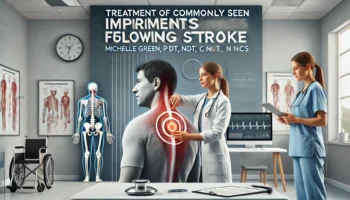Stroke Rehab for Patients who Push”: Management Strategies for a Unique Patient Population – Michelle Green
Stroke Rehab for Patients who Push”: Management Strategies for a Unique Patient Population – Michelle Green Download. This lab-intensive, recording will sh…
Overview
Discover the Best Learning with Stroke Rehab for Patients who Push”: Management Strategies for a Unique Patient Population – Michelle Green
WisMentor is your ultimate destination for online learning. Explore "Stroke Rehab for Patients who Push”: Management Strategies for a Unique Patient Population – Michelle Green" by top authors and instructors, designed to transform your skills and career. Start now and unlock your potential!
Salepage check: Stroke Rehab for Patients who Push”: Management Strategies for a Unique Patient Population
Author: Michelle Green

Pushing behavior presents serious challenges during stroke rehabilitation. Patients who push are often low level, need a lot of assistance, have considerable safety concerns, and do not respond to typical treatment interventions. This recording will show you how to address the root causes of pusher syndrome.
This lab-intensive, recording will show you how to address the root causes of pusher syndrome with evidence-based treatment activities and progressions. Learn how to assess and address the limiting impairments of pusher patients, utilizing the ICF model and principles of neuroplasticity to select the right intervention at the right time, and to maximize treatment outcomes.
Additionally, appropriate assessment tools and functional performance tests will be practiced in order to apply treatment ideas in any environment. You will come away with techniques applicable to other patients who present with similar impairments such as difficulty with midline, retropulsion, trunk malalignments, postural control deficits, and gait dysfunction, making this course a great investment! This dynamic course will take your treatments to the next level!
- Discuss current literature regarding suggested pathology of “pusher syndrome”
- Recognize and list common characteristics and functional presentation of a patient who “pushes”
- Develop a skill set for understanding normal movement as well as executing task analysis for assessments of impairments limitations
- Discuss the criteria critical in categorizing the “pusher” patient as a low, mid, or high-level “pusher”
- Identify appropriate treatment interventions for the low, mid, and high-level “pusher” patient to specifically improve noted activity limitations
- Practice supporting and positioning techniques that enhance safely for the clinician and patient
- Strategize progressions of interventions to reduce impairments and lessen activity limitations to maximize participation for each patient with “pusher syndrome”
ICF MODEL AND ROLE IN ASSESSMENT AND TREATMENT
- ICF Models guide to clinical reasoning
- Levels of ICF definitions and examples
- Correlation with assessment, prognosis and treatment planning
PATHOPHYSIOLOGY OF “PUSHING”
- Role of vestibular system
- Localization of lesions correlating with “pushing”
- Thalamic lesions and “pushing”
- Role of graviceptive systems
- Best support for occurrence of “pushing”
COMMON CHARACTERISTICS OF “PUSHERS”
- Alignment faults (trunk, head, pelvis, femur)
- Movement dysfunction
- Midline deficits
- Other (sensory loss, visual, neglect, cognition)
ASSESSMENT TOOLS
- Tests to confirm presence of “Pushing”
- Outcome measures
- Role of upper and lower trunk assessment
TASK-ANALYSIS, HYPOTHESIS DRIVE APPROACH
- Why use this framework for clinical reasoning
- What is the framework
- How it guides tasks assessment and guides treatment choices
- How to execute a task analysis
- Neuroplasticity and directing treatment
choices - Motor control and motor learning theories on set-up and progression
TREATMENT SET-UP FOR SUCCESS (REDUCE RISK, IMPROVE SAFETY, IMPROVE OUTCOMES)
- Choosing a position for treatment
- Align patient for best results
- Activate muscles in coordinated sequenced fashion to mimic functional demands
- Rehabilitation of function
- Compensation or Recovery?
TREATMENT FOR THE LOW, MID AND HIGH-LEVEL “PUSHER”
- Primary characteristic for each level
- Starting point and progression
- Functional re-education considerations
- Use of objects, adjunct, and equipment in treatment
About Stroke Rehab for Patients who Push”: Management Strategies for a Unique Patient Population – Michelle Green and Our Expert Authors
Stroke Rehab for Patients who Push”: Management Strategies for a Unique Patient Population – Michelle Green is part of our extensive collection of over 70,000 premium courses at WisMentor. Created by renowned authors and industry leaders, this course is tailored to provide cutting-edge knowledge and actionable insights.
Why Choose WisMentor?
- 🌟 Access courses from world-renowned authors.
- 📚 Wide range of topics to suit your professional and personal growth needs.
- 💼 Lifetime access and flexible learning options.
Key Features of Stroke Rehab for Patients who Push”: Management Strategies for a Unique Patient Population – Michelle Green:
- ✅ Comprehensive content covering essential topics.
- ✅ Evidence-based methodologies and practical examples.
- ✅ Learn at your own pace with expert guidance.
How to Access Your Course?
Getting started is easy:
- 📩 Receive an instant download link via email.
- 🌐 Access your course anytime through your account dashboard.
- 📱 Compatible with all devices for a seamless experience.
Need Help?
Our dedicated support team is here to assist you. Visit our Contact Us page or reach out via email for any queries or assistance.
More from Our Collection:
Don’t miss the opportunity to explore more courses from top authors and enrich your learning journey at WisMentor. Find your next course now and take your skills to the next level.


